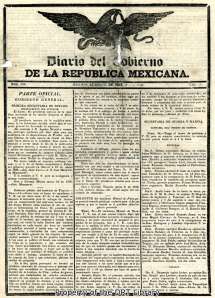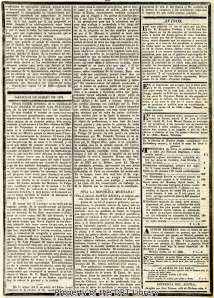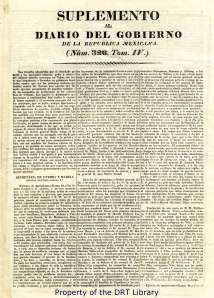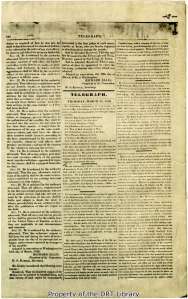
The second page of the Telegraph and Texas Register from March 24, 1836. The article about the Alamo begins on the right-hand column under the heading "More Particulars Respecting the Fall of the Alamo."
The DRT Library’s newspaper collection includes papers published in the spring of 1836 containing “news from Texas.” While the majority of these materials were published in American cities, also included is a photocopy of the Telegraph and Texas Register published in San Felipe, Texas, on March 24, 1836. According to Todd Hansen, editor of The Alamo Reader, this document “is probably the most influential single account of the fall of the Alamo by virtue of being the first in print, its access to authoritative sources, and its near universal dissemination” (551). Indeed, argues Hansen, this account “would be the picture of the fall for Texans (and the United States) and the starting point for all later secondhand accounts” (565).
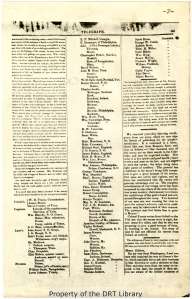
According to Todd Hansen, the casualty list included in the Telegraph and Texas Register account is "particularly valuable" because it was "based on the most authoritative sources known in Washington-on-the-Brazos" at the time (565).
Another important newspaper account of the fall of the Alamo in the library’s collections can be found in the Diario del Gobierno de la Republica Mexicana published on March 21, 1836. The draft of a 1968 press release announcing the library’s acquisition of the document states that it is “a rare copy of a Mexican newspaper containing the earliest known official announcement of the fall of the Alamo.”
As the official newspaper of the Mexican government, the Diario celebrated the bravery and success of Mexican officers and soldiers in achieving what is described as a complete and brilliant victory. “Long Live the Mexican Republic!” proclaimed the headline of this article, “Long live General Santa Anna and the brave army, victors of the Fort of the Alamo in Texas!”
A supplement to this edition of the newspaper contained additional details about the Alamo, specifically General Santa Anna’s report about the battle, his March 5th General Order outlining the plan for the assault, and a March 3rd letter from General Urrea to Santa Anna describing the former’s victory over James Grant’s men at San Patricio. The article also includes a Spanish translation of Robert McAlpin Williamson’s March 1st letter to Travis. Taken from Travis’s body or his quarters, the letter concludes with Williamson’s impassioned statement, “For God’s sake hold out until we can assist you.” The Diario supplement may be the first printing of the text of the letter; since the original manuscript of this letter has never been found, the publication is significant for revealing its existence.
Like other primary sources describing the siege and battle of the Alamo, newspaper accounts contain some confusing, problematic, and contradictory statements that researchers are still exploring, analyzing, and debating. For example, the report published in the Diario del Gobierno de la Republica Mexicana claimed that more than 600 Texans were killed, an estimation three times the actual number. Additionally, while only seventy deaths are attributed to the Mexican force, actual losses are estimated to be up to 600 soldiers.
An inventory for the entire newspaper collection can be accessed by visiting the DRT library; we are in the process of editing the guide so that it can be accessed and searched via the library’s online catalog.
Click here for a full citation of documents and images included in this entry.
